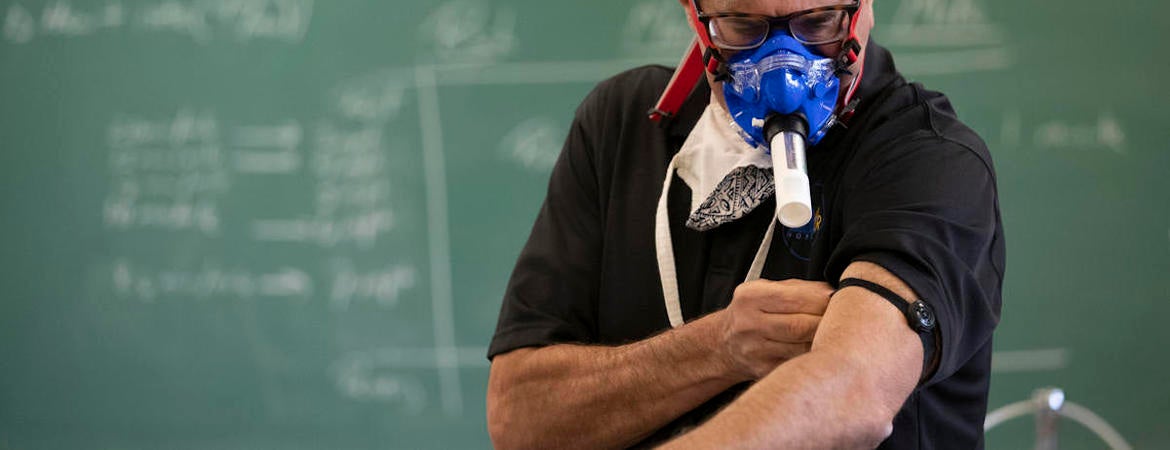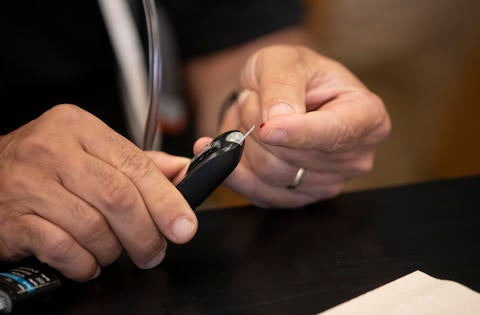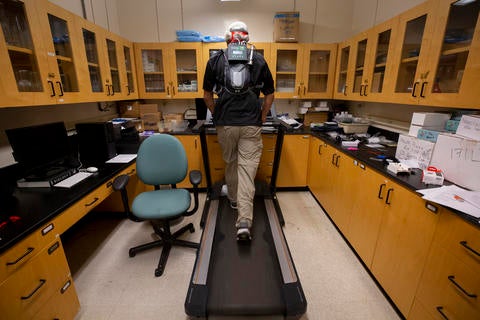
Just call him Professor Guinea Pig. Adapting to remote learning this quarter, Professor Rich Cardullo is performing all the experiments for his human physiology laboratory course — on himself.
Picture a video in which your professor puts electrodes on his thighs and has a teaching assistant hit his knees, so you can see the impact of the hammer on his reflexes. Imagine watching him draw his own blood to see how his glucose levels plummet following a sweet soda or perform a urinalysis to check for kidney function.
“This is not the way it was designed to happen, but let’s be honest, you’ve all wanted to see your professors hurt themselves,” Cardullo jokes to his students. “Now it happens every week!”
Normally, his 100-plus students learn to analyze blood, urine, muscles, heart and other body functions by collecting data from themselves. Now, with the help of academic coordinator Michael Fugate and graduate teaching assistants Margaret Schmill, April Arquilla, and Tiffany Chiu, the course has transformed into something meaningful with just a small number of live participants. “I am going full out with my colleagues to get through this COVID-19 issue,” Cardullo said.
For the unit on exercise physiology, Cardullo hopped on the treadmill with a mask and “sensors everywhere” in order to measure the amount of oxygen and carbon dioxide moving in and out of his lungs as well as his pulse and blood pressure as he pushed himself to reach the maximum recommended heart rate. For the curious, the formula for maximum heart rate is equal to the number 220 minus your age.
Parameters like resting heart rate, blood pressure, the capacity to exchange oxygen and carbon dioxide, and the rate at which air flows through the lungs are important for at least two reasons. For one, they’re used to establish baselines for healthy people. When changes in these baselines occur, they can be dealt with via shifts in habits like exercise, healthier eating, or better sleeping habits. Secondly, they help diagnose medical conditions including lung infections, asthma, heart valve problems, arrhythmias, and more.
Pushing himself to the max is nothing new for Cardullo, now entering his 30th year at UCR. He has served as chair of the Biology Department from 2004-09, was divisional dean of life sciences for the College of Natural and Agricultural Sciences from 2010-12 and is currently the Howard H Hays Jr. chair and faculty director of University Honors.
Cardullo was originally recruited as a biophysicist working on reproduction in various animals. The first class he taught at UCR, with 300 students, an introductory course in cell and molecular biology, was one that he himself had never taken. He’s had to take on new responsibilities many times in his three decades with the university, and the quick pivot to remote learning is just one of those times.
Though it’s been difficult in a number of ways, this new teaching style has had some silver linings. Students no longer have to commute. And, his students interact with one another through Zoom breakout discussions in ways that they never would in a larger classroom. “The shy people are much more talkative, and at a much higher level,” he said.
In addition, Cardullo will be able to use the video recordings of all these experiments on himself even after he resumes teaching the lab to on-campus students again. “You spend time going over concepts, and that reduces lab time. Now I can use 20 minutes’ worth of videos that students can watch before they come into lab, and I’ve freed up time where students can get right to work,” he said.
The lab is typically taken by students interested in becoming physicians, nurses, or other health professionals and who have previous training in biology, chemistry, biochemistry, and physics. All of that background is needed to fully understand physiology, Cardullo said, because it is really the study of how these systems work together to respond to various challenges.
“With their prior knowledge looking at a wide array of complex organisms including other animals and even plants, we can demonstrate that humans respond in much the same way as other mammals,” Cardullo said. “There are differences of course, and at some level that makes it interesting and personal for the students.”
For readers interested in trying their own experiment at home, Cardullo says that measuring heart health is relatively easy and not too expensive. A newer digital blood pressure cuff will also track heart rate and allows for the comparison of these measurements during rest, exercise, and at different times of the day.
In addition to being fun, this data could be beneficial to physicians, since there could be more information from this experiment than a doctor might get in a single reading performed during a checkup or when you’re sick. “I know that my blood pressure is elevated from stress just knowing that I’m in a doctor’s office,” he said.





